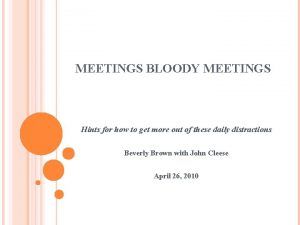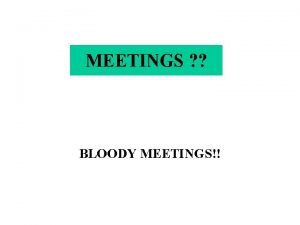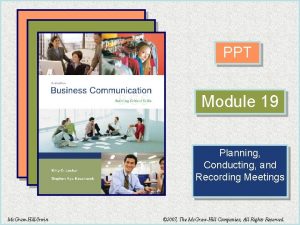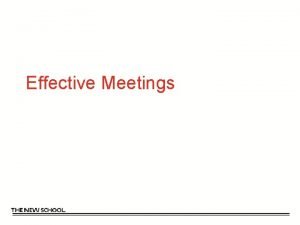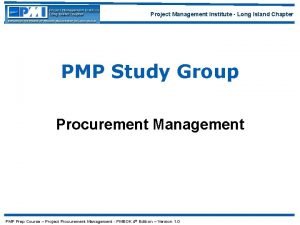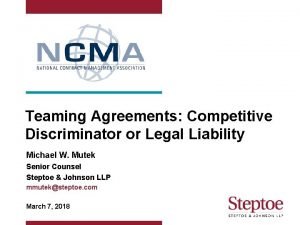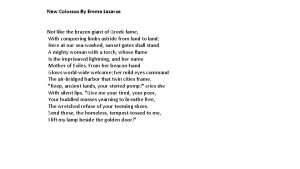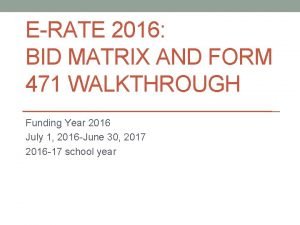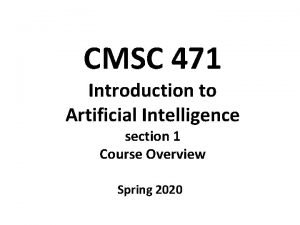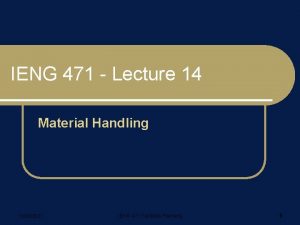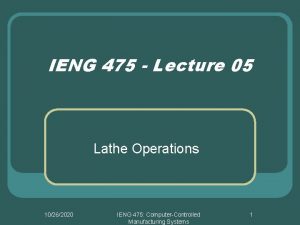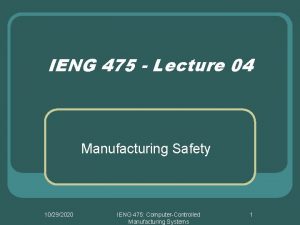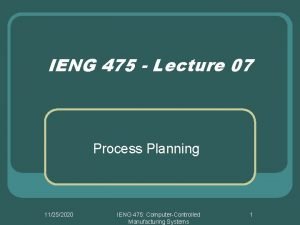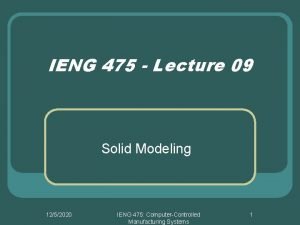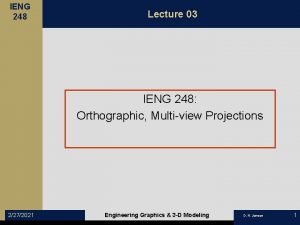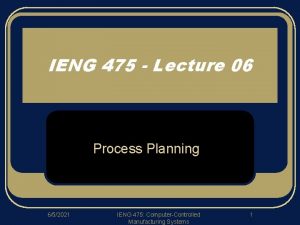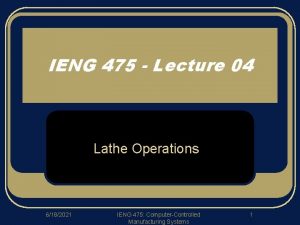IENG 471 Lecture 08 Teaming and Effective Meetings















- Slides: 15

IENG 471 - Lecture 08 Teaming and Effective Meetings 9/18/2020 IENG 471 Facilities Planning 1

Teaming Factors What makes for a good project team? l 1. 2. 3. 4. 5. Clear, challenging goal Results-driven team structure Competent members Commitment to team goal(s) Positive team culture • • 6. 7. 8. 9/18/2020 Honesty Openness Respect Performance consistency High team standards for performance External support and recognition Effective leadership IENG 471 Facilities Planning 2

Successful Team Life Cycle l Five Stages of Team Development l l l (Tuckman & Jensen) Forming Storming Norming Performing Adjourning l Not Everyone, Every Team Goes Through All Stages l l 9/18/2020 Some opt-out Some teams are aborted IENG 471 Facilities Planning 3

Stage 1: Forming l Brief Description: l Transformation of individuals into team members l Characteristics: l Struggle to: • • l As a group, members are: • • • 9/18/2020 Define nature of the task to be performed Knowing each other’s personalities, motives, work styles… Determining acceptable group behavior Determining where, when, how to begin Likely to be polite, but guarded Passive, and dependant on a leader to tell them what to do Need a nurturing and structured environment IENG 471 Facilities Planning 4

Stage 2: Storming l Brief Description: l Similar to adolescence, team members vie for control over the group and the way the group will work together. l Characteristics: l Conflicts, because the team has unrealistic expectations for themselves, and others: l Some success leads to over-reaching l High energy, enthusiasm, optimism at the same time as frustration, resentfulness and restlessness l Polarization and scape-goating as team self-identifies l Some may voluntarily (or be forced to) leave the group 9/18/2020 IENG 471 Facilities Planning 5

Stage 3: Norming l Brief Description: l Team resolves their basic differences and begins to work together in atmosphere of cooperation, respect. l Characteristics: l Remaining members have become more accepting of: l Each other l Their own roles l The team’s goals and objectives l Members: l Share information willingly l Communicate openly l Solve problems effectively l Begin to understand individual strengths & weaknesses l Start to identify as a group, socialize, some become friends 9/18/2020 IENG 471 Facilities Planning 6

Stage 4: Performing l Brief Description: l Members feel intimacy with each other and gain a great deal of satisfaction from interaction l Characteristics: l l l 9/18/2020 No issues over power, control, or status Members work through problems as part of the interpersonal and team dynamics in an open manner Team is productive, efficient, highly focused Credit is shared Members recognize that a synergy occurs as they work together IENG 471 Facilities Planning 7

Stage 5: Adjourning l Brief Description: l The team accomplishes its mission and disbands. (This phase does not always occur) l Characteristics: l l Period of letting go and moving on with individual lives Members recognize that their time as a group is over, consequently, mixed emotions prevail: l There is a sense of loss l There is some remorse, sadness, and grieving l There is pride is what they achieved l There is pride in having been a special group l 9/18/2020 If team members don’t experience some of these feelings, the team probably never reached Stage 4 IENG 471 Facilities Planning 8

Successful Team Key Behaviors l Communication l Ability to restate, express concisely, solicit feedback, accept criticism l Decision-Making l Ability to gather input from all affected, consider options and alternatives, advocate a differing view, encourage risk-taking l Collaboration l Ability to commit to team purposes, support team members, share responsibility and credit, accept weaknesses and strengths of other team members l Self-Management l 9/18/2020 Ability to communicate and stay focused, commit to quality work, meet professional and personal standards, empower others without controlling them, and get yourself started IENG 471 Facilities Planning 9

Effective Meetings l Member Roles Primary Facilitator l Scribe l Timekeeper l Secondary Facilitator(s) l 9/18/2020 IENG 471 Facilities Planning 10

Effective Meetings: Roles l Primary Facilitator l. Prior to meeting: l Purpose of meeting l Agenda for meeting l State desired outcomes for meeting l Assign roles for Scribe & Timekeeper l. During the meeting: l Responsible for beginning l Drawing information from all members l Processing information l Aid in drawing conclusions & developing actions l Keeping the meeting on track l Contributing to the meeting 9/18/2020 IENG 471 Facilities Planning 11

Effective Meetings: Roles l Scribe l. During the meeting: l Records proceedings of the meeting l Provides feedback on what is recorded l Checks for consensus l Act as a secondary facilitator l. After the meeting: l Sends notes of the meeting l. Minimal Notes: l Date, time, location and attendees l Actions completed, discussion points and decisions l Task assignments and target dates 9/18/2020 IENG 471 Facilities Planning 12

Effective Meetings: Roles l Time. Keeper l. During the meeting: l Keeps meeting on schedule l Assist in keeping meeting on track l Act as a secondary facilitator l Secondary Facilitator(s) l. Prior to the meeting: l Perform assigned tasks l. During the meeting: l Actively contribute to the meeting l Volunteer to take on assignments 9/18/2020 IENG 471 Facilities Planning 13

Facilitation for Effective Meetings 1. Start the meeting on time (3 people starting point) 2. Ask members for information, opinions, and feelings 3. Paraphrase what was said to aid understanding 4. Ask for specific examples to comprehend 5. Clarify assumptions 6. Probe ideas: depth = insight 7. Summarize key points & issues 8. Encourage consideration of all information 9. Reflect on expressions and member feelings 10. Refocus on issues when necessary 11. Draw out differences of opinion 12. Encourage “out of the box” thinking about issues 13. Recommend processes for moving forward 14. Test for consensus 15. Move the team forward: help make decisions, identify actions 9/18/2020 IENG 471 Facilities Planning 14

Questions & Issues l Each team will need to send a bi-weekly progress report memo (e-mail): l Addressees: l Dr. Jensen (dean. jensen@sdsmt. edu) l Team members l l Subject: IENG 471 Progress Report - <date> Content: l Summary of actions on old tasks l Summary of decisions made l Summary of next tasks and responsible personnel l 9/18/2020 1 st Meeting: Team Organization Include hardcopy in your project report. Due every other Friday at Noon. IENG 471 Facilities Planning 15
 5 letter words with ieng
5 letter words with ieng John cleese meetings bloody meetings
John cleese meetings bloody meetings Meetings bloody meetings
Meetings bloody meetings Meetings bloody meetings 5 points
Meetings bloody meetings 5 points Conducting effective meetings ppt
Conducting effective meetings ppt 4 p's of effective meetings
4 p's of effective meetings Effective meetings guidelines
Effective meetings guidelines Vertical teaming in education
Vertical teaming in education Hyper-v cluster best practices
Hyper-v cluster best practices Teaming agreement pmp
Teaming agreement pmp Teaming agreement workshare language
Teaming agreement workshare language Emma lazarus quote
Emma lazarus quote 01:640:244 lecture notes - lecture 15: plat, idah, farad
01:640:244 lecture notes - lecture 15: plat, idah, farad Form 471
Form 471 Cmsc 471 umbc
Cmsc 471 umbc Cse 471 asu
Cse 471 asu

